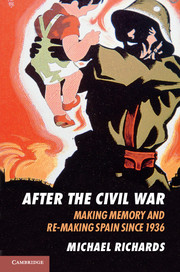Book contents
- Frontmatter
- Contents
- List of maps and tables
- Preface
- Acknowledgements
- Maps
- Introduction: cultural trauma in Spain
- Part I Setting the scene
- Part II Memories of war during the Franco years
- 3 Repression and remembrance: the victors’ liturgy of memory
- 4 Repression and reproduction: social memory in the 1940s
- 5 Memory and politics: from civil war to Cold War
- 6 Memory and migration: flight from the countryside in the 1950s
- 7 Commemorating ‘Franco's peace’: the 25th anniversary of the Victory
- 8 Contesting ‘Franco's peace’: transformation from below in the 1960s
- 9 Transition and reconciliation: politics and the Church in the 1970s
- Part III Memories of war after Franco
- Conclusion: the history of war memories in Spain
- Glossary and abbreviations
- Sources and select bibliography
- Index
- References
3 - Repression and remembrance: the victors’ liturgy of memory
Published online by Cambridge University Press: 05 June 2013
- Frontmatter
- Contents
- List of maps and tables
- Preface
- Acknowledgements
- Maps
- Introduction: cultural trauma in Spain
- Part I Setting the scene
- Part II Memories of war during the Franco years
- 3 Repression and remembrance: the victors’ liturgy of memory
- 4 Repression and reproduction: social memory in the 1940s
- 5 Memory and politics: from civil war to Cold War
- 6 Memory and migration: flight from the countryside in the 1950s
- 7 Commemorating ‘Franco's peace’: the 25th anniversary of the Victory
- 8 Contesting ‘Franco's peace’: transformation from below in the 1960s
- 9 Transition and reconciliation: politics and the Church in the 1970s
- Part III Memories of war after Franco
- Conclusion: the history of war memories in Spain
- Glossary and abbreviations
- Sources and select bibliography
- Index
- References
Summary
Caudillo of Spain: [. . .] Thousands of companions during the captivity were brutally dragged away from our cells and knew how to face death, looking only at Spain, and repeating your name so that our tormentors would recall it at the moment of justice which has now dawned [. . .] Dignified by the bloody persecution perpetrated by the enemies of the patria, treated without pity for thirty-two months, the ex-captives are distinguished as a select group of Spaniards to be singled out for missions of leadership and vigilance. They, as no other group, know the value of our victory [. . .] They will remind us of those fallen on the battlefield and in the innumerable immolations which were decreed by the Red terror [. . .] They will translate the words of the dead and pass on their mandate.
In January 1940 the recently founded National Association of Ex-prisoners (‘ex-cautivos’), constituted by those who had suffered imprisonment in the Republican zone during the civil war and led particularly by captives in the Modelo prison in Madrid, produced an emotive public message of loyalty directed personally to General Franco which conferred charismatic status upon him and summarised the special claim on memory of the conflict made by those who were able to portray themselves openly as its victims.
The civil war lacerated the lives of the defeated and of many of the victors, though recognition of this in the aftermath varied greatly depending on opportunity and capacity to partake of the spoils of victory. The wartime experience has been explored in the previous chapter and the aftermath for the defeated will form the main theme of the next. Here, the ways in which the nascent state encouraged associations of ex-captives, ex-combatants and the families of ‘martyrs’ to remember, and how various groups of ‘memory activists’, including Falangists and Catholics, came to construct a sense of collective trauma, will be explored. Many set themselves up as moral witnesses to the tragedy, and they employed the familiar tropes of collective memory after war: ‘redeeming the sacrifice’; ‘the spirit of a generation’; ‘blood irrigating the growth of a new nation’; rebirth and regeneration; the ‘moral values of the victory’: austerity, discipline, vigilance and intransigence.
- Type
- Chapter
- Information
- After the Civil WarMaking Memory and Re-Making Spain since 1936, pp. 69 - 96Publisher: Cambridge University PressPrint publication year: 2013

